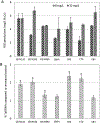Comparative and mechanistic toxicity assessment of structure-dependent toxicity of carbon-based nanomaterials
- PMID: 34111749
- PMCID: PMC10631494
- DOI: 10.1016/j.jhazmat.2021.126282
Comparative and mechanistic toxicity assessment of structure-dependent toxicity of carbon-based nanomaterials
Abstract
The wide application of carbon-based nanomaterials (CNMs) has resulted in the ubiquity of CNMs in the natural environment and they potentially impose adverse consequences on ecosystems and human health. In this study, we comprehensively evaluated and compared potential toxicological effects and mechanisms of seven CNMs in three representative types (carbon blacks, graphene nanoplatelets, and fullerenes), to elucidate the correlation between their physicochemical/structural properties and toxicity. We employed a recently-developed quantitative toxicogenomics-based toxicity testing system with GFP-fused yeast reporter library targeting main cellular stress response pathways, as well as conventional phenotype-based bioassays. The results revealed that DNA damage, oxidative stress, and protein stress were the major mechanisms of action for all the CNMs at sub-cytotoxic concentration levels. The molecular toxicity nature were concentration-dependent, and they exhibited both similarity within the same structural group and distinctiveness among different CNMs, evidencing the structure-driven toxicity of CNMs. The toxic potential based on toxicogenomics molecular endpoints revealed the remarkable impact of size and structure on the toxicity. Furthermore, the phenotypic endpoints derived from conventional phenotype-based bioassays correlated with quantitative molecular endpoints derived from the toxicogenomics assay, suggesting that the selected protein biomarkers captured the main cellular effects that are associated with phenotypic adverse outcomes.
Keywords: Carbon blacks (CBs); Fullerenes; Graphene nanoplatelets (GNPs); Nanotoxicity; Quantitative toxicogenomics assay.
Copyright © 2021. Published by Elsevier B.V.
Figures





References
-
- Kemp KC, Seema H, Saleh M, Le NH, Mahesh K, Chandra V, Kim KS, Environmental applications using graphene composites: water remediation and gas adsorption, Nanoscale 5 (8) (2013) 3149–3171. - PubMed
-
- Goenka S, Sant V, Sant S, Graphene-based nanomaterials for drug delivery and tissue engineering, J. Control. Release 173 (2014) 75–88. - PubMed
-
- Akhavan O, Ghaderi E, Toxicity of graphene and graphene oxide nanowalls against bacteria, ACS Nano 4 (10) (2010) 5731–5736. - PubMed
-
- Unfried K, Sydlik U, Bierhals K, Weissenberg A, Abel J, Carbon nanoparticle-induced lung epithelial cell proliferation is mediated by receptor-dependent Akt activation, Am. J. Physiol. Lung Cell. Mol. Physiol 294 (2) (2008) L358–L367. - PubMed
-
- Hussain S, Boland S, Baeza-Squiban A, Hamel R, Thomassen LCJ, Martens JA, Billon-Galland MA, Fleury-Feith J, Moisan F, Pairon J, Marano F, Oxidative stress and proinflammatory effects of carbon black and titanium dioxide nanoparticles: role of particle surface area and internalized amount, Toxicology 260 (1–3) (2009) 142–149. - PubMed
Publication types
MeSH terms
Substances
Grants and funding
LinkOut - more resources
Full Text Sources
Molecular Biology Databases

